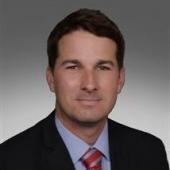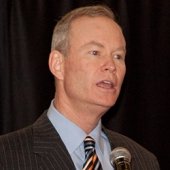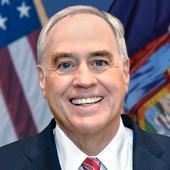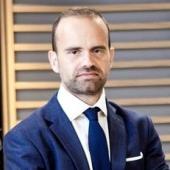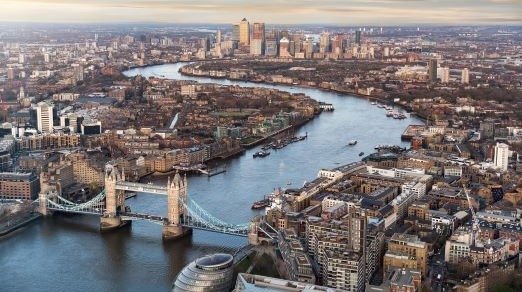How Los Angeles is shaping the future of the urban air mobility movement
IN BRIEF
- 1:50 – The three E's: “We had a vision to make Los Angeles being the technology transportation capital of the world around three key themes: equity, environment, and the economy.”
- 12:03 – Up off the ground: “Then FAA is expected to certify an urban air mobility aircraft in 2023 and if that goes well, a lot of operators are looking at the year 2024 to get this off the ground.”
- 14:35 – Leading the way: “Right now, transportation is a way to move around L.A., sometimes very slowly. Through the use of transportation technology, I’m optimistic L.A. will be a model for other cities to follow in 2030 and beyond.”
Los Angeles is where dreams become reality—and seamlessly integrating air mobility into a city-wide, sustainable and equitable urban transportation network may just be the next dream come true in Los Angeles. Watch this video where Joe Kornik, VISION by Protiviti’s Editor-in-Chief, discusses the possibilities with two LA officials—Julia Thayne DeMordaunt, an executive officer focused on mobility innovation in the office of Mayor Eric Garcetti, and Clint Harper, Los Angeles air mobility fellow.
HOW LOS ANGELES IS SHAPING THE FUTURE OF THE URBAN AIR MOBILITY MOVEMENT - Video transcript
Joe Kornik: Welcome to the VISION by Protiviti interview. I’m Joe Kornik, Director of Brand Publishing and Editor-in-Chief of VISION by Protiviti, our new quarterly content initiative where we put mega trends under the microscope and look far into the future to examine the strategic implications of big topics that will impact the C-Suite and executive board rooms worldwide. In this, our first topic, the future of cities, we’re exploring the evolution urban areas are undergoing post-COVID and how those changes will alter cities over the next decade and beyond.
Today, I’m joined by Julia Thayne DeMordaunt, an executive officer with focus on mobility innovation in the office of Mayor Eric Garcetti, along with Clint Harper, Los Angeles air mobility fellow. Los Angeles, under Mayor Garcetti’s leadership, is at the forefront of all kinds of mobility initiatives that will not only drive the future of the city, but will help drive the urban air mobility movement worldwide. Some exciting stuff coming out of the city of Los Angeles. So, Julie and Clint, thank you so much for joining me this afternoon.
Julia Thayne DeMordaunt: Absolutely. Thanks for having us.
Clint Harper: Yes. It’s great to be here.
Kornik: As I mentioned in my introduction, really impressive where the city of Los Angeles is right now when it comes to sort of shaping the future of urban mobility. Why is this such a huge priority for the Garcetti administration?
DeMordaunt: It’s a fantastic question. When the mayor started his administration eight years ago at this point, his vision from the very beginning was for LA to be the transportation technology capital of the world. He knew that LA’s past was very much about poor air quality, about congestion, about building more highways. Its future needed to be the opposite of that. So, he really set out this vision powered by 3 E’s, so Equity, Environment and the Economy, to have LA be setting the tone and doing the future of mobility. In terms of why we decided to take that approach it’s because we knew that we wanted companies to headquarter and hire here, and we’ve made progress on the front across all types of transportation technology companies. We knew that zero emissions had to be the standard, that if we were going to get rid of that poor air quality, we have to start out with a sustainable mode of transportation and use that as the baseline.
Then finally, in terms of equity, it was about Angelenos. Angelenos want to try things. They want better mobility options. They need to get to work or to hospitals, or to wherever else. So, all three of those E’s were really at the center of this vision of LA being the transportation technology capital of the world. With that said, there’s still a long way to go, and we know that to get there, we need a flexible policy framework. So, a lot of the work that I do is around setting up that flexible policy framework to get to that future of mobility that we all want.
Kornik: Yes. Thanks. I know one of the bigger initiatives that I’ve been reading about is sort of the Urban Movement Lab, which I think brings communities, local government and mobility innovators into sort of a think tank to explore the future and bring sort of some of the big ideas to life. Julia, I know you’re actually on the board for that effort. So, can you tell us a little bit about the work that it’s doing and some of the important innovations that are emerging from that Urban Movement Lab?
DeMordaunt: It’s very much linked to what I just mentioned, which is that LA, in order to be that capital of transportation technology, needs to have this flexible policy future. I think we, as policy makers in LA, know that the public sector, the private sector, and communities all have to work together to deliver it. In terms of Urban Movement Labs, it was set-up to bring those three groups together and to help accelerate some of the transportation technology projects. In the past, we’ve had sort of an antagonistic [Laughter] relationship between public and private sectors. They haven’t always gotten along when it comes to trying things and trying things quickly. There’s also been some one-off dialogues with community, rather than having more of an ongoing discussion. Urban Movement Labs exist so that we could have collaboration and not antagonism between public and private sectors, and so there can be that ongoing dialogue with the community. Urban Movement Labs has been fantastic since we founded it two years ago at this point. It’s very much an outsource innovation arm for the city and it helps city staff to grapple with new transportation technologies. It provides some immediate clarity to companies who want to test things here but they’re confused by California [Laughter] legislation or they’re confused by local legislation.
Then finally, I think having this objective third-party broker with communities helps to articulate needs and co-design solutions in a way that wasn’t happening before. I’m very excited about all the work that Urban Movement Labs is doing. They’re doing curb mapping and management, zero emissions, last-mile delivery pilots. There’s an affordable electric free floating car sharing program, which is just fantastic. Then, the sky’s literally the limit. That’s why Clint is on this call too, because Urban Movement Labs is doing a lot of work on urban air mobility as well.
Kornik: You mentioned urban air mobility, so let’s talk about it. Sort of a fancy way of saying flying taxis or flying cars, drones. There’s all sorts of ways we can talk about them. I know that Los Angeles is part of a pilot program with the World Economic Forum and sort of released the principles of the urban sky a little while ago. The two organizations are LA and World Economic Forum. Clint, can you walk us through those and sort of where that stands right now, where we are in that process?
Harper: Absolutely. So, a little background on me. I have 21 years of aviation experience, and when I really entered into this vast air mobility space, it was to advocate for community integration and community involvement within the planning. Really, the principles of the urban sky were a response to the flurry of announcements coming from industry about their operational plans. Now in particular, many vehicle manufacturers targeted Los Angeles for introductory services. As the industry is pressing forward with a lot of well-intentioned ideas of how to advance air mobility to the city, they were doing it without much feedback or input from the cities themselves. In the case of urban air mobility, cities have taken the lessons learned from the introduction of ride sharing, macro ability, and started to proactively plan for a thoughtful integration. This is really the nexus of the seven principles of the urban sky.
Of course, safety is paramount in anything to do with aviation. The impeccable safety record the aviation has on the commercial side of the operations is something that we want to maintain, that we want to facilitate. Safety is the first principle of the urban sky, sustainability is the second one. We really want to improve environmental outcomes and embrace innovation to achieve more sustainable behaviors. This is really a system’s response and the system’s take on urban air mobility, which is something that I think is critical as new transportation technologies are evolving. Then, of course, there’s equity of access. The equity of access is something that’s very important to the FAA, but they’re looking at equity of access to the air space. Well, we want to do that and look at what is the equity of access for the folks on the ground, not just to the airspace itself, but for the widest range of demographics that we can possibly enable.
Being in Los Angeles, there is a lot of helicopter traffic. Urban aviation isn’t new to the city. What most people associate with that is noise, and so encouraging manufacturers and operators to embrace the low-noise potential of these new aircraft is something that we’re really pushing to get out there. We want to make sure that as we address this, we’re taking it community by community and using a community-first approach to it all.
The second, also going into the introduction, the industry was looking at using ride sharing networks to really expand what urban air mobility was going to do and how to solve that first and last mile problem. That’s another thing that I wanted to address. Ride sharing is great, but if we really want access, as many people and give people as many options as possible we need multi-model connectivity. Connectivity and integration into the existing transit networks, connectivity to transportation links, so we want to promote walkability and bicycle safety, and just safe pedestrian environment, to the extent that we can with urban air mobility.
The next principle of the urban sky is local workforce development. What we’re trying to encompass with this is understand all the jobs that are going to be created through the introduction of urban air mobility and advanced air mobility. These are jobs that are going to be associated with manufacturing the aircraft, servicing the aircraft, maintaining the aircraft, and providing support services, and understanding what the training needs are going to be associated with those jobs and preparing local residents to fill them is something that we’re trying to understand and we want to make sure that we’re ready to fill those jobs and to support the industry as it’s needed.
The last principle of the urban sky is purpose-driven data sharing. Really, what this targets is, we’re trying to get to an optimized system, an optimized transportation system where all providers across all modes are able to quickly respond and meet passenger needs and passenger demand, and also meet market demand on this.
Kornik: Yes, Clint. I mean, some really exciting things there. I’m just curious. How excited should we be about urban air mobility? Will it be a niche sort of amenity for the wealthy or do you envision it becoming mass transit eventually? Is this the big game-changer that we’ve sort of been hearing about for a little while now, and when will it be reality? When can we expect this to sort of take off?
Harper: I think that it certainly has the opportunity to be the big game changer with all this. What we do not want is it to be a niche amenity for the wealthy or the privileged. We want it to be a part of the solution. I think that’s maybe where the industry got off on the wrong foot when they kind of advertised what urban air mobility was and they posited it as a solution to congestion and the solution to air quality issue. I want to make sure that we understand that we are not the solution. Urban air mobility is not the solution. It’s a part of the solution. As we integrate this into a wider transportation network, we have the chance to optimize the system and robust traffic connections, and pedestrian connections, extra transportation connections, and just really be a game changer in that way and that we’re contributing to a more efficient and optimized system.
The thing that I think a lot of the OEMs and the vehicle manufacturers are waiting for is aircraft certification, which is in the FAA’s court right now. It’s not something that they take lightly. They want to make sure that these aircraft are safe, that they’re going to respond in a variety of different environments. People are asking, how is this going to respond in weather? How are they going to respond when power is lost? Just a host of different scenarios. The FAA really accounts for that and its aircraft certification process, for that reason, is a slow and grueling process that the manufacturers have to go through. With it, the FAA is expecting to certify an aircraft around 2023, if all continues to go smoothly. With that date in mind, I know a lot of the operators are looking at the 2024 launch to take this off the ground.
Kornik: Wow. That’s sooner than I thought and not that far off. So, last question for me, and I’ll ask you to look a little further out in 2024. That’s for you to sort of paint the picture of Los Angeles and mobility in, let’s say, 2030 and beyond, even beyond. Go out as far as you’d like to dream of what can be the reality. What’s that future look like for LA and mobility in 2030 and beyond.
Harper: You know, not being a native Angeleno, I’ll speak a little bit more broadly and within my own history of aviation, I would like for all modes of transportation to really break out of their planning silos. I want us to work together, because our goal is to provide transportation solutions. I think right now, there is a lot of competition. People are framing urban air mobility to be a competitor with transit. I don’t think that needs to be the case. A transit has a role in getting point A to point B. Personal vehicles have a role in getting people from point A to point B. Ride shares have a role and urban air mobility is going to have a role.
To make that happen efficiently, safely and in optimized manner, we really need to get out of the silos and start talking to each other. How can I make urban air mobility a tool of transit? How can I make urban air mobility a tool of the new rail system, the high-speed rail system? How can we complement each other into an integrated system? That’s my ultimate goal for 2030 and beyond. I want us to start planning for an integrated system that gets folks from point A to point B in the best and most efficient way possible.
Kornik: Julia, any thoughts on this?
DeMordaunt: My dream, what I want to have reality be in 2030 is no traffic, bikes everywhere, 72 degrees and sunny all the time, clean air, just that perfect transportation utopia as I see it. That said, [Laughter] I think that’s not everybody’s transportation utopia. What I would love to see in 2030 in LA is that transportation is both a verb, a way to move around, and a noun, a place to stay. I think we have a reputation now, and for that matter, is reality that transportation is very much a way to move around LA, albeit slowly, but our streets are not really safe places for pedestrians, cyclists, or scooter-ers, [Laughter] people who want to be in something other than a car. By 2030, I think LA will really be both. We’ll have that multi-modal network that I was describing earlier that connects Angelenos to where they want to go. It’s got to be affordable, it’s got to be quick, and it’s got to be in a way that gives people some joy. When we were doing our scooter trials, there were some streets in LA where they were more scooter trips than there were car trips. People were having fun. People were using scooters because they had fun on them, not to mention that they provided a mobility service. I think we need to promote that in 2030 and beyond.
The other vision that I have is about street space. I think we need street space and street views to be right-sized. We’ve got to give some of that street space back for housing. We’ve got to give some of it back for open space. Like I said before, it needs to be safe for people just to be on the street, let alone to be trying to move across it. The other thing I think about a lot is the mobility future and the land use future or housing future in LA are in its strictly length. That’s true everywhere, but I think that’s especially true in Southern California. We’ve got to have dignified and affordable housing options, services nearby, and some of my other colleagues in the mayor’s office are doing some really interesting work around how we get more housing in Southern California through better design and also through these more dignified options, like I mentioned. I’d love for the transportation, the housing, and the land use people all to get together to create that beautiful transportation future.
So, I am very hopeful, very optimistic, and although I didn’t mention [Laughter] transportation technology in that answer, I do really think that we will be seeing much more transportation technology options in that 2030 timeframe and further out.
Kornik: Yes. Clearly, I think LA will be a model for other cities to follow because LA is clearly doing many, many things right, as you point out and I’m really excited to sort of watch the future with you. Thanks again for being here.
Julia Thayne DeMordaunt is an executive officer with focus on mobility innovation in the office of Los Angeles Mayor Eric Garcetti. She is an expert at the leading edge of systemic change for transportation policy and programs helping governments, private companies and not-for-profit organizations translate ambitious visions into actionable plans that benefit the communities they impact.
Clint Harper is an Urban Air Mobillity Fellow with the City of Los Angeles.
Did you enjoy this content? For more like this, subscribe to the VISION by Protiviti newsletter.





